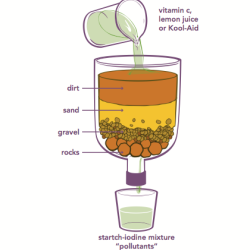Source Institutions
Source Institutions
Add to list Go to activity
Activity link broken? See if it's at the internet archive

This is an activity (located on page 3 of the PDF under Water Clean-up Activity) about the use of reduction agents to decontaminate ground water. Learners will conduct a reduction-oxidation (redox) reaction in which vitamin C acts as a reduction agent after passing through a model of top soil, sand, and gravel to "pollutants" (starch-iodine mixture). This simulates how nanoparticles of iron are being used to detoxify water under former factory sites. Relates to linked video, DragonflyTV Nano: Water Clean-up.
- 10 to 30 minutes
- 2 to 4 hours
- $10 - $20 per group of students
- Ages 8 - 14
- Activity, Experiment/Lab Activity, Model, Simulation
- English
Quick Guide
Materials List (per group of students)
- iodine (from a drugstore)
- water
- spray starch (liquid form — not aerosol — is best)
- rocks
- pebbles
- sand
- dirt
- clear cups
- old soda bottles (20 ounce) with caps
- ring stands or pieces of cardboard
- vitamin C tablets
- lemon juice
- Kool-Aid (clear)
- Popsicle sticks
- white paper
- drill
Subjects
-
Earth and Space Science
-
Earth Structure
- Oceans and Water
-
Earth Structure
-
Engineering and Technology
-
Engineering
- Metallurgy and Materials Engineering
- Mineral and Mining Engineering
- Nanotechnology
-
Engineering
-
Life Sciences
-
Ecology
- Human Impact
-
Ecology
-
Mathematics
-
Data Analysis and Probability
- Data Analysis
- Data Collection
- Data Representation
-
Measurement
- Rate
- Representation
-
Data Analysis and Probability
-
The Nature of Technology
-
Technology and Society
- Impacts of Technology
- Technology and the Environment
-
The Design Process
- Invention and Innovation
-
Technology and Society
-
Physical Sciences
-
Chemistry
- Chemical Reactions
- Acids and Bases
- Oxidation-Reduction Reactions
-
Structure and Properties of Matter
- Atomic Structure
- Elements and Periodic Table
- Volume and Density
-
Chemistry
-
The Nature of Science
-
The Scientific Process
- Conducting Investigations
- Gathering Data
- Formulating Explanations
- Communicating Results
-
The Scientific Process
Informal Categories
- Model Building
- Nature and Environment
Audience
To use this activity, learners need to:
- see
- see color
- read
- touch
Learning styles supported:
- Involves teamwork and communication skills
- Uses STEM to solve real-world problems
- Involves hands-on or lab activities
Other
Components that are part of this resource:
Includes alignment to state and/or national standards:
This resource is part of:
Access Rights:
- Free access
By:
Source Collection
- DragonflyTV
Rights:
- All rights reserved, Twin Cities Public Television, Inc., 2008
Funding Source:
- National Science Foundation, 741749
